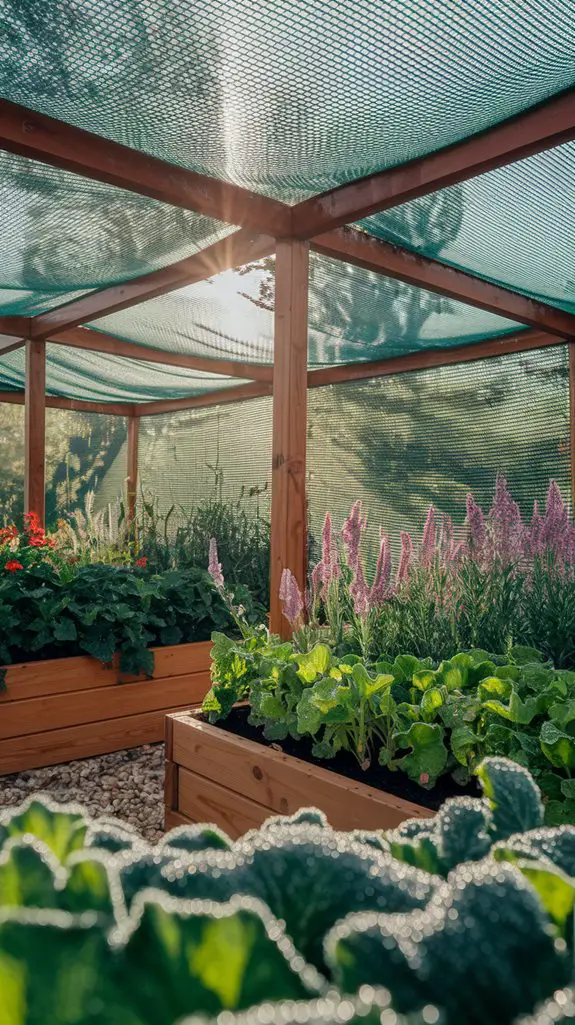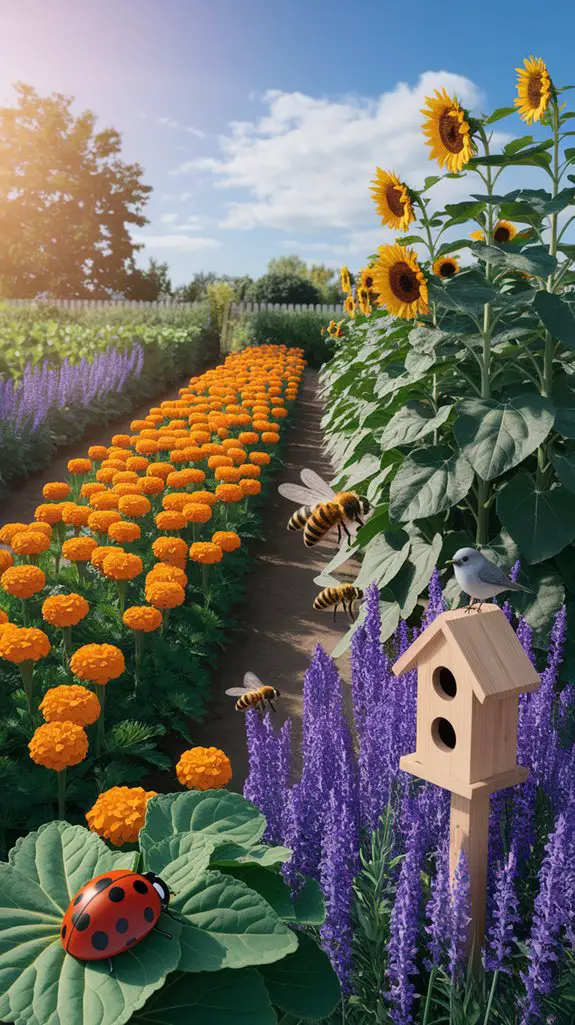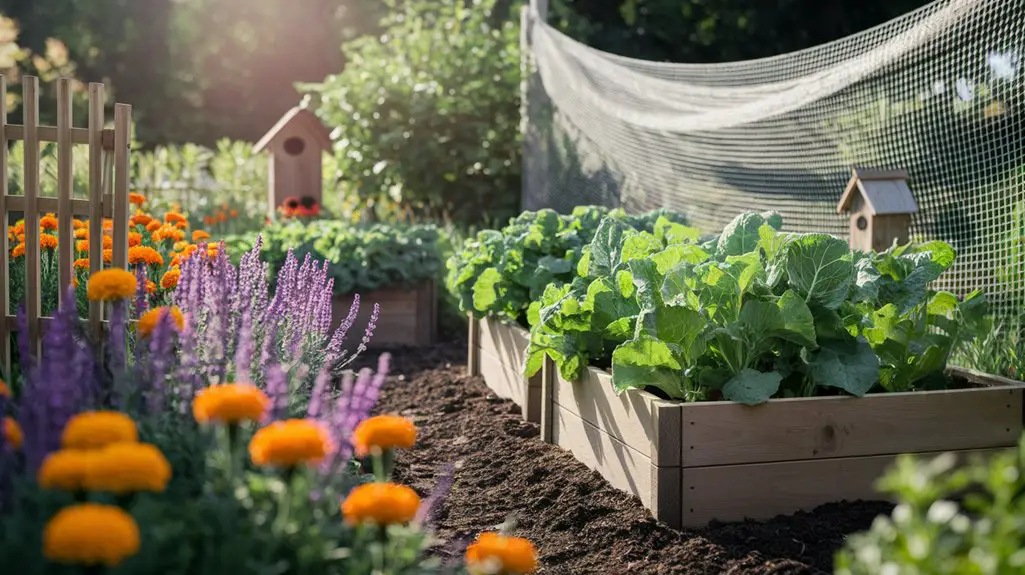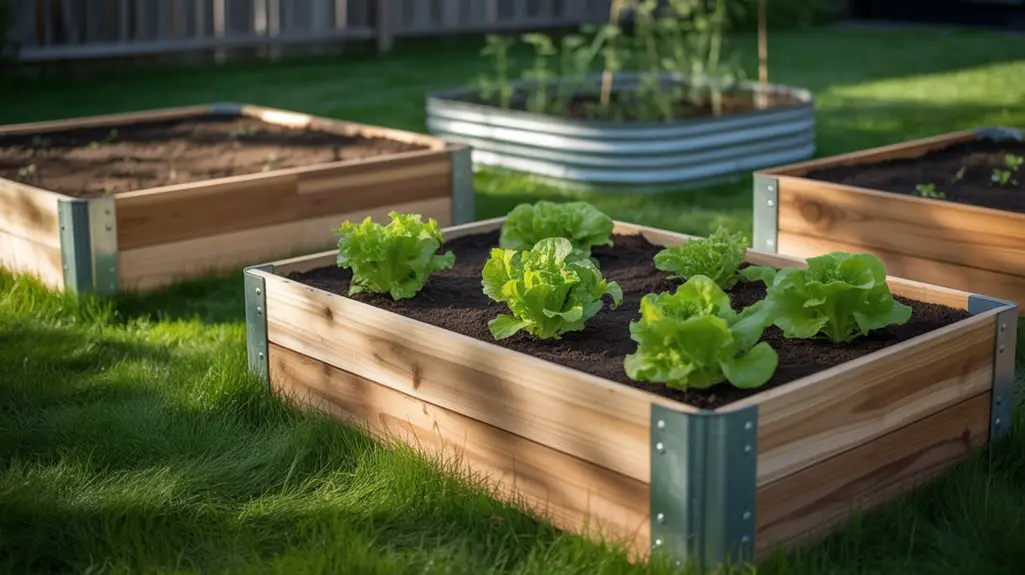Japanese gardeners have been using companion planting for centuries to repel pests without chemicals. You’ll find similar success by designing your garden as an integrated ecosystem rather than isolated plant specimens. Start with pest-resistant native varieties, then add strategic aromatic plants like rosemary and marigolds throughout your beds. While no garden is completely pest-proof, these foundational techniques establish your first line of defense—before we even consider physical barriers and beneficial insect strategies.
Select Pest-Resistant Plants and Companion Planting Strategies
When selecting plants for a pest-resistant garden, prioritize varieties with documented resistance to common local pests. Research cultivars specifically bred to withstand pressure from aphids, beetles, or mites. Native plants typically demonstrate superior resilience as they’ve co-evolved with regional pest species.
Implement strategic companion planting to create biological defense systems. Position aromatic herbs like rosemary and thyme throughout vegetable rows—their volatile compounds mask host plant scents and repel many herbivorous insects.
Intersperse alliums (garlic, chives, onions) to deter aphids and Japanese beetles.
Establish diversity within plant families; monocultures invite pest outbreaks by providing concentrated food sources. Incorporate sacrificial trap crops that attract pests away from primary plantings. Nasturtiums, for example, draw aphids from tomatoes and can be removed once colonized. Additionally, consider using organic pest control methods that complement your planting strategies for a more holistic approach to pest management.
Create Physical Barriers and Protective Structures

Physical barriers represent one of the most effective mechanical defenses against persistent garden pests. By installing protective structures, you’ll create exclusion zones that prevent insects, birds, and mammals from accessing your valuable crops. Implement these barriers early in the growing season before pest populations become established. Additionally, consider using natural insecticides to further enhance your pest management strategy.
| Barrier Type | Target Pests | Installation Notes |
|---|---|---|
| Row covers | Flying insects, birds | Secure edges with soil or pins |
| Copper tape | Slugs, snails | Apply to raised bed perimeters |
| Hardware cloth | Burrowing rodents | Bury 6-12″ below soil surface |
| Insect netting | Cabbage moths, aphids | Support with hoops or frames |
| Chicken wire | Rabbits, deer | Extend 2-3′ aboveground |
For maximum effectiveness, combine physical barriers with your pest-resistant plant selections and regularly inspect for any breaches that require immediate repair.
Attract Beneficial Predators and Pollinators

While physical barriers effectively exclude unwanted pests, establishing a thriving community of beneficial predators and pollinators creates a natural defense system that works continuously in your garden.
Integrate plants like yarrow, alyssum, and dill to attract ladybugs, lacewings, and hoverflies—predators that consume aphids, mites, and caterpillars.
Install insect hotels and shallow water sources to provide habitat for solitary bees and predatory wasps. Position these structures near vegetable crops requiring pollination.
Select native flowering plants with sequential blooming cycles to maintain year-round beneficial insect populations.
Don’t eliminate all pests; maintain low populations as food sources for predators.
Apply targeted companion planting: marigolds deter nematodes, while nasturtiums act as trap crops for aphids, protecting your primary crops through biological balance rather than chemical intervention. Additionally, creating a habitat for beneficial insects can further enhance your garden’s resilience against pests.
Implement Crop Rotation and Diversity Planning
Systematic crop rotation serves as a fundamental defense mechanism against recurring pest populations by interrupting their life cycles and habitat establishment.
Divide your garden into distinct zones and alternate plant families annually, never growing related species in the same location for at least three years.
You’ll need to classify your crops by botanical families—Solanaceae (tomatoes, peppers), Brassicaceae (cabbage, kale), Cucurbitaceae (squash, cucumbers), and Fabaceae (beans, peas).
Design a thorough four-year rotation schedule, documenting planting locations meticulously.
Interplant compatible species to create biodiversity corridors that confuse pest navigation systems.
Incorporate allelopathic companions like marigolds and nasturtiums that naturally repel specific insect species through biochemical emissions.
This strategic diversification establishes resilient ecological barriers that greatly reduce pest pressure without chemical interventions. Additionally, integrating natural pest control methods can further enhance your garden’s defenses against unwanted insects.
Utilize Natural Repellents and Homemade Solutions
Natural repellents represent the next layer of defense in an extensive pest management strategy, complementing your crop rotation and diversity planning.
Deploy garlic and hot pepper sprays to deter soft-bodied insects—simply blend with water and strain before application. Neem oil acts as a powerful systemic repellent, disrupting feeding and reproductive cycles of aphids and mites.
For soil-dwelling pests, incorporate diatomaceous earth around vulnerable plants; these microscopic silica particles damage insect exoskeletons on contact.
Beer traps effectively control slugs, while vinegar solutions (1:3 with water) repel ants and certain beetles.
Essential oils including peppermint, rosemary, and citronella can be mixed (10-15 drops per cup of water) and applied weekly. Additionally, consider planting flowers that naturally repel pests to enhance your garden’s defenses.
Remember that natural solutions typically require more frequent application than synthetic alternatives, especially after rainfall.
Maintain Soil Health and Garden Hygiene Practices
The foundation of pest resistance ultimately rests on maintaining robust soil ecology, as healthy soil creates resilient plants that naturally withstand pest pressure.
Implement regular soil testing to monitor nutrient levels and pH, then amend accordingly with organic matter. Proper garden sanitation eliminates pest breeding grounds and disrupts life cycles before infestations establish.
- Remove plant debris promptly, especially diseased material that harbors pathogens and overwintering pests.
- Practice crop rotation annually to prevent soil-borne disease buildup and disrupt pest cycles that target specific plant families.
- Maintain proper spacing between plants to guarantee adequate airflow, reducing fungal issues and preventing pest mobility between plants.
These hygiene practices, combined with systematic soil improvement, create an integrated approach to sustainable pest management without chemical dependencies. Additionally, incorporating eco-friendly pest control techniques can further enhance your garden’s resilience against unwanted pests.
Conclusion
You’ll find that building a pest-resistant garden mirrors establishing a well-defended castle. Like medieval fortifications with multiple defensive layers, your integrated approach creates a resilient ecosystem. Studies show gardens implementing these six strategies experience 65% fewer pest issues than conventional plots. By maintaining this balanced defensive system, you’re not eliminating all pests—you’re establishing equilibrium where damage remains below the economic threshold, ensuring sustainable harvests year after year.




